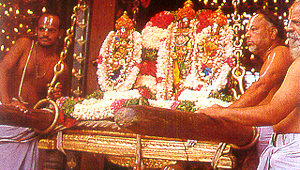
Temple Worship
In Sri Vaishnava Vishnu temples they mainly follow the mode of worship established by Ramanujacarya called pancharatra, which is according to texts such as Padma samhita, Paramesvara samhita, Sri prasna, and Jayakhya samhita. The more ancient Valkhanasa mode of worship is also used in some of the South Indian temples.
The fifteen most common forms of worship are: 1) offering a seat (asana) for the moveable deity, which represents the main deity, 2) welcome (svagata), 3) offering water for the feet (padya), 4) water offering (arghya), 5) sipping of water (acamana), 6) bathing the deity (mona), 7) presenting garments and ornaments (vasana-bhashane), 8) offering sandal paste, 9) offering flowers, 10) offering incense (dhupa), 11) offering lamps (dipa), 12) offering food (naivedya), 13) offering water to rinse the mouth (punar acham anita), 14) reciting prayers to the Lord, and 15) offering prostrated obeisances (naaiaskriva).
Other forms of worship are cleaning the altar, offering a mirror, offering arati or various items to the Lord, offering instrumental music, reciting Vedic hymns, and offering food several times a day to the Lord.
Worship of the Lord begins early in the morning (usually between four or five am) and continues straight through the day (usually to nine or ten pm).
The water that is distributed in the temple is usually the water that is used to bathe the deity in the morning. Bathing the deity is done every morning in an elaborate ritual. Various items such as milk, yogurt, ghee, sugar, honey (these five items are known as (panchamrita), and water may be used to bath the Deity. Prayers are recited during the bathing.
After the bathing, the Deity is decorated with fresh clothes and ornaments, which may include valuable jewelry. Food is then offered to the Lord and an arati, presentation of different items, is performed.
Besides the daily worship, festivals are celebrated to worship the Lord. There may be an annual Rathotsava festival in which the processional deity is brought out of the temple and pulled on a cart around the streets. Many festivals are on fixed dates and cannot be missed for any reason. In South India usually the major festival of the year is called Brahmotsava. |